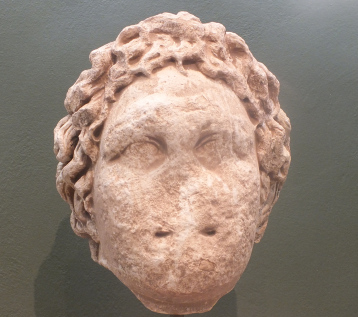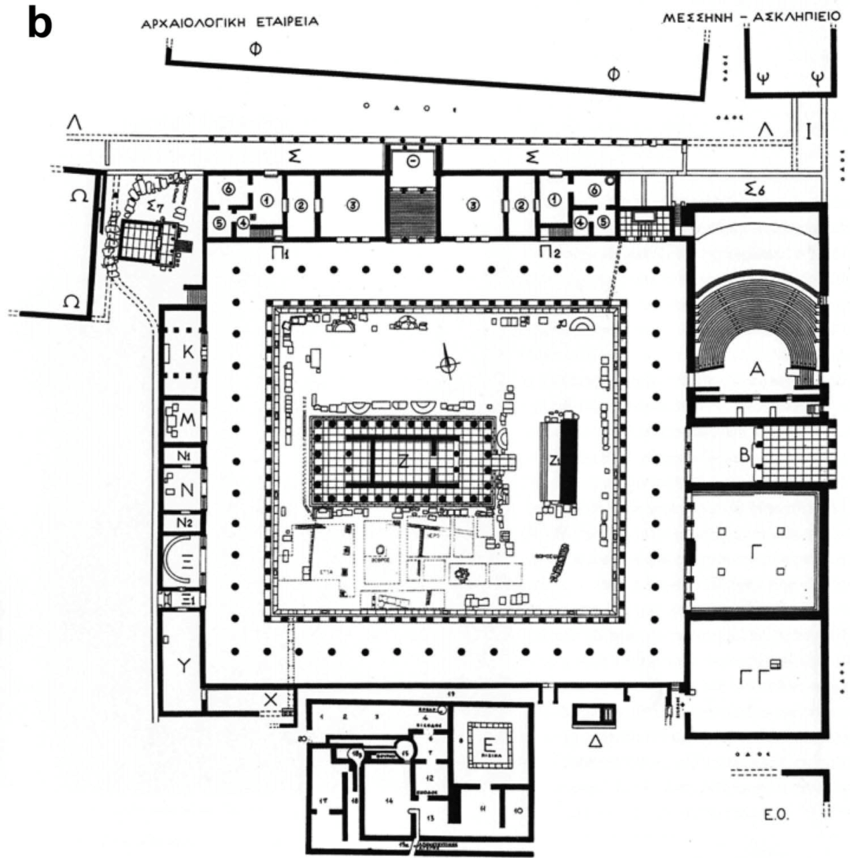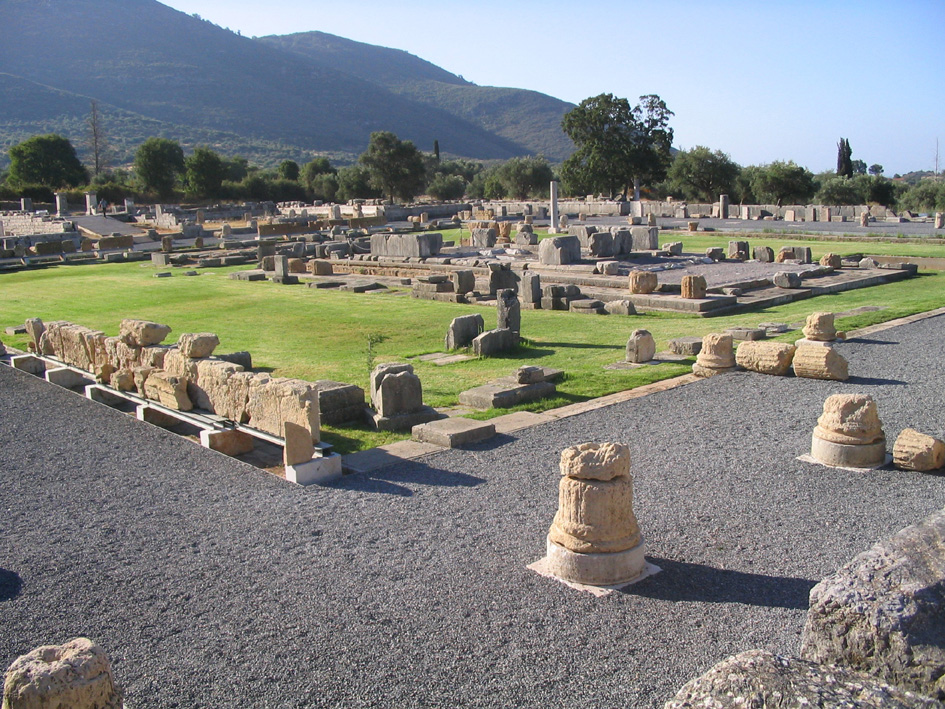Sanctuary of Asclepius, Messene
The Sanctuary of Asklepios in Messene was one of, what is believed to be, over 300 healing temples located across Ancient Greece. According to Greek mythology, the doctor-demigod Asclepius had great healing powers and thus the healing temples were set up in his name. It is likely, however, that at this site, Asklepios took a more civic duty.
Asclepius is believed to have been from the area of Messene, with the Iliad referencing his origins being from Ithome.
Pilgrims would come to the sanctuary seeking spiritual and physical healing.
Archaeological Development
Messene was founded in 396BCE. Lying in a fertile valley in the south-east of the Peloponnese, and in the shadow of Mount Ithome, it was easily defendable. The area is surrounded by an impressive large wall.
What likely started out as a small shrine to Asklepios grew to include a densely packed area of important city structures, stoas lined with statues, and the political centre of the polis.
The temple is built in the Doric style, and was mostly built from local limestone.
Use of the complex continued throughout the Hellenistic and Roman period with restorations happening sporadically. By the late 4th century AD, it had fallen out of favour – likely due to the rise of Christianity.
Gods/Heroes
As an Asklepion, it’s major god was Asklepios. He was the main god of the city, a role he rarely fulfilled, likely due to the rise in his popularity coinciding with the city’s liberation from Spartan rule. Asklepios was the god of medicine within the Greek pantheon.
As well as Asklepios, his daughter, Hygieia, was worshipped in the sanctuary – she was the goddess of hygiene and health.
Further to this, the sanctuary held statues of other local deities and hero figures, as recorded by Pausanias, and the surviving statue bases we have. Directly next to the Asklepion is a temple of the twelve Olympians, called the Hierothysion.
It is also likely that Messene, the goddess of the city, was worshipped side-by-side with Asklepios in the in the sanctuary, as there is scant evidence for her own temple elsewhere.
Ritual Activity
There is an expectation, in its role as an Asklepion, that rituals of purification and incubation would take place here. The archaeological evidence of a bath support this.
Traditionally, visitors to the temple of the Asklepios would be searching for some form of healing and would engage in ritual practice here in order to receive this. The specific rituals vary widely from area to area, and the details of ritual worship at this specific Asklepion are unknown.
Due to the lack of dedications to Asklepius as a healer, it is likely that Asklepius was mostly worshipped here as a civic god, connected to the area through his lineage. However, the inclusion of political structures – an ekklesiasterion and a bouleuterion – suggest that the god took a more political role within the polis. This creates a portrayal of the god as having taken a more domestic role within the city, not just stuck in his role as a healer.
The discovery of a 2nd Century CE instrument at the site suggests that there may have been some form of musical festival in the area.
Rules and Regulations
Little is known about the specific practices at this particular Asklepion, however it can be expected that the traditional practices of purification must have taken place prior to engagement with the sanctuary.
It is also likely than the Asklepion played some form of role in the politics of the polis, due to Asklepios' role as a civic god.
Other Activities
The presence of political structures would place the sanctuary as one of the central parts of the polis. It would suggest the town had grown around the sanctuary and held it of high importance throughout all that it did.
Pausanias’ description of the number of famous statues at the temple would also suggest that the area was a sort of tourist destination, a museum of famous figures from around Greece.
Historical Significance
It’s a small sanctuary, from a small place, with little dedicatory material left. While the buildings and architecture survive, little evidence of religious practice does.
Pausanias, Description of Greece 4. 31. 10 :
"The most numerous statues and the most worthy seeing [at Messene, Messenia] are to be found in the sanctuary of Asklepios. For besides statues of the god and his sons, and besides statues of Apollon, the Mousai (Muses) and Herakles, the city of Thebes is represented and . . . Tykhe (Fortune), and Artemis Bringer of Light. The stone statues are the work of Damophon."
Who used the site, and where did they come from?
The site was presumably of great significance to Messenian people, having built their major political structures around it. It could have been used by anyone from the local area wishing to seek healing or to partake in civic affairs. It may have been visited by people drawn from further afield due to its famous statues, wherein it would have acted more like a museum, akin to that described by Pausanias.
Select Site Bibliography
Pausanias, Descriptions of Greece, 4.31.10-12
Homer, Iliad, 2.729-32, 4.193-5, 11.514-5
Entire website based on the site
Themelis P., Cults on Mount Ithome, Kernos 17 (2004), 143-154.
Müth-Herda S., Street Network and Town Planning of Ancient Messene, in Ito J. (ed.), Symposium for International Collaborative Studies on Ancient Messene, Kumamoto 2002, 16-30.
Dickins, Guy. “Damophon of Messene.” The Annual of the British School at Athens, vol. 12, 1905, pp. 109–136.
Footnotes
Figure 1 - Retrieved from Wikimedia Commons, accessed 7th February 2020
Figure 2 - Retrieved from Romancegreece.wordpress.com, accessed 7th February 2020
Figure 3 - Retrieved from Kernos, accessed 7th February 2020
Fig 1. The Asklepion at Messene. Stoas surround the Asklepion at the centre of the image.

Fig 2. Head of Herakles statue, by Damophon. Found at Messene.
Location
Messene, South-West Peloponnese. About 80 kilometers west of Sparta, and 100 kilometers south of Olympia.
Co-ordinates - 37.175372, 21.920524
Site Plan

Fig 3. Site Plan of the Asklepion at Messene, and its surrounding features. The Asklepion in the centre, the Ekklesiaston in the upper right.

